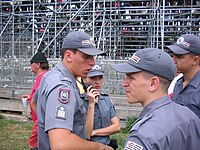2006 São Paulo violence outbreak
This article documents a current event. Information may change rapidly as the event progresses, and initial news reports may be unreliable. The latest updates to this article may not reflect the most current information. |
The 2006 São Paulo violence began on May 12, 2006 in São Paulo, Brazil, the largest city in South America. The violence began after forty São Paulo police officers were killed by gang violence. Subsequently, the police officers sought to find the gang members behind the criminal acts. In the process, a violent situation arose, creating a clash between law enforcement officials and criminals and taking the lives of over 150 people.
The violence
| Casualties* | |
|---|---|
| Military Police | 23 dead / 22 wounded |
| Civilian police | 7 dead / 6 wounded |
| City guard | 3 dead / 8 wounded |
| Prison guards | 8 dead / 1 wounded |
| Prisioners | 9 dead |
| Civilians | 4 dead / 16 wounded |
| Suspected Criminals | 109 dead |
| Total | 163 dead / 53 wounded[1] |
| *as of 5/18/06 | |
Since early Friday May 12, 2006 there have been 180 attacks against public establishments such as police stations, justice forums, buses, etc; which are allegedly organized by the Primeiro Comando da Capital criminal organization.
The violence represents the bloodiest assault of its kind in the history of Brazil's richest state, São Paulo, and the news has reached the international media.[2] [3] [4] [5] Related uprisings at 20 prisons across São Paulo were taking place Saturday, May 13. The attacks are not limited, however, to the state of São Paulo, as they have reached other states, such as Bahia, Mato Grosso do Sul and Paraná.[6] [7] [8]
The attacks came in response to 7 imprisoned PCC leaders, among them, Marcos "Marcola" Willians Herbas Camacho, the leader of the criminal organization who allegedly ordered the attacks, being transferred and placed in solitary confinement in the Presidente Venceslau penitentiary. The practice was used by authorities to sever prisoners' ties to gang members outside prison.
The power of the PCC has been heightened in recent years by the availability of mobile phones inside their jail cells. The lack of surveillance to prevent prisoners from communicating with criminals on the outside allowed them a powerful tool to spread information and coordinate uprisings and attacks in the state. Measures are being discussed, in the future, they might either remove mobile phone service antennas from the districts with penitentiaries, or increase the quality of surveillance inside jail cells, with metal detectors and other tools that would assist in locating cell phones.

The waves of attacks were orchestrated by PCC leaders supposedly in jail, using said mobile phones, but it is arguable that the general chaos encouraged other criminals to take advantage of the situation.
The ministry of Justice, led by Márcio Thomaz Bastos, offered assistance by making available all federal security forces and the army, but São Paulo State Governor Cláudio Lembo said this is not necessary at the moment and that São Paulo can handle the situation without assistance.[9]
May 15th was a very unusual day in São Paulo. This was the first work day after the attacks had been reported in the media, so the effects were now apparent as ever, with chaos marking the height of the attacks. On one hand, many people decided to stay home in fear of becoming a victim of violence. Also, one third of the public bus fleet stayed in the garages as they are a frequent target for attacks, being burned down and used to barricade streets and establishments. Consequently the residential neighborhoods were ghost towns, whilst the avenues were choked with traffic because of the lack of public transportation. The compulsory carpool law was lifted for the day. Those who did go to work decided to go home early and the roads were congested long before peak hours. The ensuing traffic jams were thought to be the greatest in the city's history spread out over 212km (150 miles).[10] That fear was spread to the population mostly due to the massive coverage by the media, who may have exaggerated the situation. In addition, many rumors of attacks and riots are being created by civilians. The situation now is "under control."
Human rights concerns
Human rights activists have stated their concerns that "innocent people may have been hurt in the strikes by police enraged by a notorious gang's attacks on officers on the streets, at their stations, in their homes, and at after work hangouts". [citation needed]
They are also saying that critics said police were using public fear and anger to rationalize unjust killings that may end up with the deaths of innocent people.
References
- ^ [http://www1.folha.uol.com.br/folha/cotidiano/ult95u121796.shtml Após uma semana, ataques atribuídos ao PCC chegam a 299 em SP]
- ^ Brazilian Gang Violence Leaves 81 Dead - Reuters, NYTimes
- ^ FOXNEWS.COM Brazilian Gang Continues Wave of Violence, Death Toll at 80
- ^ BBC NEWS More die in fresh Brazil violence
- ^ CNN.com Gang rampages in Brazil's biggest city; more than 80 killed
- ^ Terra: Rebeliões em delegacias do Paraná são encerradas (in brazilian portuguese).
- ^ Terra:Termina última rebelião em presídios do MS (in brazilian portuguese)
- ^ Três ônibus são incendiados na Bahia - Estadao.com.br, 15/05/06
- ^ Terra: Todas as forças federais estão à disposição, diz Bastos (in brazilian portuguese)
- ^ Terra: São Paulo tem recorde de lentidão do trânsito
